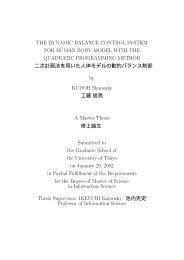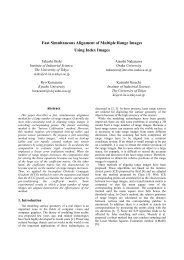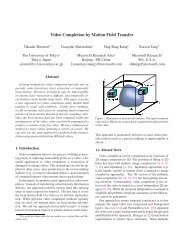モーションキャプチャと音楽情報を用いた舞踊動作解析手法 - 池内研究室
モーションキャプチャと音楽情報を用いた舞踊動作解析手法 - 池内研究室
モーションキャプチャと音楽情報を用いた舞踊動作解析手法 - 池内研究室
You also want an ePaper? Increase the reach of your titles
YUMPU automatically turns print PDFs into web optimized ePapers that Google loves.
† †† †<br />
The Structure Analysis of Dance Motions using Motion Capture<br />
and Musical Information<br />
Takaaki SHIRATORI † , Atsushi NAKAZAWA †† , and Katsushi IKEUCHI †<br />
() <br />
<br />
<br />
<br />
<br />
<br />
<br />
<br />
<br />
<br />
<br />
<br />
1. <br />
<br />
<br />
[1]<br />
<br />
(metrics) <br />
<br />
<br />
metrics <br />
<br />
<br />
<br />
<br />
<br />
<br />
<br />
† <br />
Institute of Industrial Science, The University of Tokyo<br />
†† <br />
Cybermedia Center, Osaka University<br />
[2]<br />
<br />
()<br />
<br />
<br />
<br />
<br />
<br />
<br />
() <br />
<br />
<br />
<br />
<br />
<br />
<br />
<br />
[3]<br />
<br />
<br />
<br />
X Vol. Jxx–X No. xx pp. 1–10 xxxx xx 1
xxxx/xx Vol. Jxx–X No. xx<br />
<br />
<br />
<br />
<br />
<br />
<br />
Self Motion Element <br />
HMM [4]<br />
<br />
[5]<br />
Dynamic<br />
Time Warping <br />
[6] <br />
<br />
Labanotation <br />
[7] Labanotation<br />
<br />
<br />
<br />
Labanotation <br />
<br />
<br />
<br />
<br />
<br />
<br />
<br />
<br />
<br />
<br />
<br />
<br />
<br />
1 <br />
() <br />
<br />
2 <br />
<br />
1 Flash <br />
[3]<br />
<br />
<br />
<br />
2 <br />
<br />
2 <br />
<br />
<br />
<br />
1 <br />
2. <br />
<br />
<br />
[8] <br />
<br />
<br />
<br />
<br />
<br />
<br />
<br />
<br />
<br />
Kim<br />
<br />
<br />
[9]<br />
1 <br />
Fig. 1 Algorithm overview<br />
3 <br />
4 <br />
<br />
5 <br />
6 <br />
<br />
3. <br />
<br />
2
[10] <br />
<br />
3. 1 <br />
<br />
() <br />
<br />
<br />
<br />
<br />
<br />
<br />
<br />
<br />
<br />
<br />
<br />
<br />
<br />
<br />
<br />
<br />
<br />
<br />
<br />
3. 2 <br />
<br />
<br />
<br />
t f <br />
d(t, f) 1 <br />
<br />
⎧<br />
⎪⎨ max(p(t, f), p(t + 1, f)) − p ′<br />
d(t, f) = (min(p(t, f), p(t + 1, f)) > = p ′ ) (1)<br />
⎪⎩<br />
0 (otherwise)<br />
p ′ ≡ max(p(t − 1, f), p(t − 1, f ± 1)) (2)<br />
p(t, f) t f <br />
2 d(t, f) <br />
<br />
1 t t + 1 2 <br />
<br />
<br />
2 <br />
Fig. 2 Onset component extraction<br />
2 <br />
<br />
<br />
<br />
1 <br />
D(t) = ∑ d(t, f) <br />
f<br />
t <br />
3. 3 <br />
3. 2 D(t) <br />
<br />
D(t)<br />
R DD ( 3)<br />
R DD (τ) = 1 T∑<br />
D(t)D(t + τ) (3)<br />
T<br />
t=1<br />
R DD(τ) D(t) τ D(t + τ)<br />
2 <br />
D(t) D(t) <br />
τ (t rhythm ) <br />
<br />
P (t) D(t) P (t) R DP<br />
( 4)<br />
R DP (τ) = 1 T∑<br />
D(t)P (t + τ) (4)<br />
T<br />
t=1<br />
D(t) P (t) <br />
t max <br />
D(t) P (t + t max ) <br />
t max (t st ) <br />
3. 4 <br />
3. 3 <br />
<br />
<br />
<br />
3. 3 D(t)<br />
3
xxxx/xx Vol. Jxx–X No. xx<br />
<br />
( 3)<br />
<br />
<br />
<br />
Fig. 4<br />
4 <br />
Body center coordinate system<br />
3 <br />
Fig. 3 Beat tracking considering slgiht changes of<br />
rhythm<br />
4. <br />
<br />
<br />
<br />
<br />
<br />
<br />
<br />
<br />
<br />
<br />
<br />
<br />
<br />
<br />
(<br />
) <br />
<br />
<br />
4. 1 <br />
<br />
<br />
<br />
<br />
x <br />
y x y <br />
z ( 4)<br />
<br />
() <br />
<br />
0 <br />
<br />
<br />
<br />
<br />
0 <br />
<br />
<br />
4. 2 <br />
4. 1 <br />
<br />
<br />
<br />
<br />
<br />
0 0 <br />
<br />
<br />
<br />
<br />
<br />
<br />
( 5)<br />
4. 1 <br />
0 <br />
<br />
<br />
<br />
( 6)<br />
4. 3 <br />
<br />
3 <br />
4
5 <br />
Fig. 5 Segmentation candidates extraction - Hands<br />
& CM<br />
6 <br />
Fig. 6 Segmentation candidates extraction - Feet<br />
<br />
(t rhythm /10)<br />
<br />
<br />
<br />
<br />
7 <br />
1 3 <br />
<br />
2 <br />
4 <br />
<br />
<br />
7 <br />
<br />
<br />
Fig. 7 Candidates refinement with musical rhythm<br />
Broken line : segmentation candidate<br />
Dotted line : estimated music rhythm<br />
4. 4 <br />
4. 3 <br />
<br />
4. 3 2 <br />
<br />
<br />
1 2 <br />
<br />
2 <br />
1 2 <br />
<br />
<br />
<br />
<br />
<br />
<br />
<br />
<br />
<br />
<br />
<br />
<br />
<br />
<br />
( 2) <br />
<br />
<br />
5. <br />
<br />
<br />
5. 1 <br />
<br />
3 <br />
<br />
<br />
<br />
<br />
USB <br />
PC wav (32000Hz<br />
16bit/sample) <br />
Vicon Motion Systems(<br />
) <br />
2 2<br />
5
xxxx/xx Vol. Jxx–X No. xx<br />
<br />
20 ( 120fps<br />
2400 <br />
200fps 4000 <br />
) <br />
<br />
<br />
<br />
<br />
<br />
<br />
<br />
20 <br />
9 12<br />
( 9)<br />
5. 2 <br />
FFT <br />
1024 <br />
256 <br />
<br />
<br />
<br />
0.704 85M.M. 0.576 <br />
104M.M. (M.M. Mälzel’s Metronome <br />
1 )<br />
8(a) 8(b) <br />
<br />
<br />
<br />
5. 3 <br />
<br />
[8]<br />
<br />
<br />
5. 3. 1 <br />
<br />
10 12<br />
<br />
<br />
<br />
<br />
<br />
<br />
<br />
(a) Aizu-bandaisan dance<br />
(b) Jongara-bushi dance<br />
8 <br />
3. 2<br />
D(t)<br />
<br />
Fig. 8 Results of beat tracking<br />
Top : amplitude, Middle : spectrum,<br />
Bottom : D(t) as described in 3. 2<br />
Straight line in spectrum : music rhythm<br />
4. 4 <br />
<br />
<br />
<br />
<br />
<br />
<br />
<br />
<br />
<br />
<br />
<br />
<br />
6
1 <br />
Table 1 Result of Aizu-bandaisan dance - a Female<br />
Dancer<br />
(/) <br />
13 89% (8/9) 5<br />
9 100% (9/9) 0<br />
2 <br />
Table 2 Result of Aizu-bandaisan dance - a Male<br />
Dancer<br />
(/) <br />
3 33% (3/9) 2<br />
9 100% (9/9) 0<br />
4. 4 1 <br />
<br />
<br />
<br />
<br />
<br />
<br />
<br />
5. 3. 2 <br />
<br />
11 <br />
3 <br />
3 <br />
Table 3 Result of Jongara-bushi dance<br />
(/) <br />
6 50% (6/12) 0<br />
9 75% (9/12) 0<br />
<br />
<br />
<br />
<br />
<br />
4. 4 1 <br />
<br />
3 <br />
<br />
<br />
<br />
<br />
6. <br />
<br />
<br />
<br />
<br />
<br />
<br />
<br />
<br />
<br />
<br />
<br />
<br />
<br />
<br />
<br />
<br />
<br />
<br />
<br />
<br />
<br />
<br />
<br />
<br />
<br />
<br />
<br />
<br />
<br />
<br />
<br />
<br />
<br />
<br />
<br />
(CREST) <br />
()<br />
<br />
<br />
<br />
<br />
[1] D. M. Gavlira: “The visual analysis of human movement”,<br />
Journal of Computer Vision and Image Understanding,<br />
73, 1, pp. 82–98.<br />
[2] D. Miyazaki, T. Oishi, T. Nishikawa, R. Sagawa,<br />
K. Nishino, T. Tomomatsu, Y. Takase and K. Ikeuchi:<br />
7
xxxx/xx Vol. Jxx–X No. xx<br />
(a)Aizu-bandaisan dance<br />
9<br />
Fig. 9<br />
(b)Jongara-bushi dance<br />
<br />
Keyposes extracted from manuals<br />
10<br />
– <br />
<br />
<br />
Fig. 10 Results of key poses extraction - Aizu-bandaisan of a female dancer<br />
Top : speed sequence, Middle : key poses extracted by our method,<br />
Bottom : key poses extracted by dancers<br />
Broken line : segmentation candidate, Straight line : music rhythm<br />
8
11<br />
– <br />
<br />
<br />
Fig. 11 Results of key poses extraction - Jongara-bushi dance<br />
Top : speed sequence, Middle : key poses extracted by our method,<br />
Bottom : key poses extracted by dancers<br />
Broken line : segmentation candidate, Straight line : music rhythm<br />
“Great buddha project: Modeling cultural heritage<br />
through observation”, In Proc. of the Sixth International<br />
Conference on Virtual Systems and MultiMedia<br />
(VSMM 2000), pp. 138–145 (2000).<br />
[3] T. Flash and H. Hogan: “The coordination of arm<br />
movements”, J. Neuroscience, pp. 1688–1703 (1985).<br />
[4] T. Inamura, Y. Nakamura, H. Ezaki and I. Toshima:<br />
“Imitation and primitive symbol acquisition of humanoids<br />
by the integrated mimesis loop”, In Proc. of<br />
International Conference on Robotics and Automation<br />
(ICRA2001), pp. 4208–4213 (2001).<br />
[5] O. C. Jenkins, M. J. Metaric and S. Weber: “Primitive<br />
based movement classification for humanoid<br />
imitation”, In Proc. of First IEEE-RAS International<br />
Conference on Humanoid Robotics (Humanoids<br />
2000) (2000).<br />
[6] , , “<br />
”, , 15 8 ,<br />
pp. 878–885 (2000).<br />
[7] , , “ labanotation <br />
– labanreader <br />
labaneditor–”, <br />
, 38-6, pp. 61–68 (1998).<br />
[8] A. Nakazawa, S. Nakaoka, K. Ikeuchi and K. Yokoi:<br />
“Imitating human dance motions through motion<br />
structure analysis”, In Proc. of International Conference<br />
on Intelligent Robots and Systems(IROS 2002),<br />
pp. 2539–2544 (2002).<br />
[9] T. Kim, S. I. Park and S. Y. Shin: “Rhythmic-motion<br />
synthesis based on motion-beat analysis”, In Proc. of<br />
ACM SIGGRAPH 2003 (2003).<br />
[10] M. Goto: “An audio-based real-time beat tracking<br />
system for music with or without drum-sounds”,<br />
Journal of New Music Research, 30, 2, pp. 159–171<br />
(2001).<br />
xx xx xx <br />
<br />
<br />
2002 <br />
2004 <br />
<br />
<br />
9
xxxx/xx Vol. Jxx–X No. xx<br />
<br />
<br />
1997 <br />
2001 <br />
()<br />
(<br />
)2003 <br />
<br />
<br />
<br />
1973 <br />
1978 <br />
MIT <br />
CMU <br />
1996 <br />
2000 <br />
<br />
<br />
D.Marr (ICCV:1990 )IEEE (CVPR:1991<br />
) (AI Journal:1992 )Fu <br />
(IEEE Trans. R&A1998 ) IEEE Distinguished<br />
Lecturer(SPS 2000 - 2001CS 2004 - 2006)IEEE<br />
Fellow<br />
10
Abstract This paper describes a dance motion analysis method considering music rhythm. In these<br />
days, many important intangible cultural properties are being lost because of the lack of successive performers,<br />
and we have started our digital archiving project of cultural intangible heritages. Our goal for<br />
archiving dance motions is to detect “primitive motions”, which consists of dance motions. In addition, we<br />
believe these primitives must be synchronized to the musical rhythm, so our proposed method automatically<br />
segments the original motion considering with estimated musical rhythm to detect the primitive motions.<br />
Key words<br />
Motion Capture, Primitive Motions, Music, Beat Tracking

















